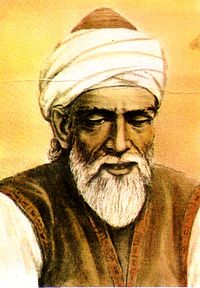
Abul Wafa Buzjani (10 June 940 – 1 July 998) (Persian: ابوالوفا بوزجانی), extended name: Abū al-Wafāʾ Muḥammad ibn Muḥammad ibn Yaḥyā ibn Ismāʿīl ibn al-ʿAbbās al-Būzjānī (Persian: ابوالوفا محمد بن محمد بن یحیی بن اسماعیل بن العباس البوزجانی) was a Persian mathematician and astronomer. He was born in Buzhgan, (now Torbat-e Jam) in Iran.
In 959 AD, he moved to Iraq. He studied mathematics and worked principally in the field of trigonometry. He wrote a number of books, most of which no longer exist. He also studied the movements of the moon. The crater Abul Wáfa on the Moon is named after him.
Astronomy
He devised a wall quadrant for the accurate measurement of the declination of stars.[citation needed] He also introduced the tangent function, which helped to solve problems involving right-angled spherical triangles, and developed a new technique to calculate sine tables, allowing him to construct more accurate tables than his predecessors.
Mathematics
He established several trigonometric identities such as sin(a ± b) in their modern form, where the Ancient Greek mathematicians had expressed the equivalent identities in terms of chords.

He also discovered the law of sines for spherical triangles:
where A, B, C are the sides and a, b, c are the opposing angles.
From Wikipedia, the free encyclopedia

Tidak ada komentar:
Posting Komentar